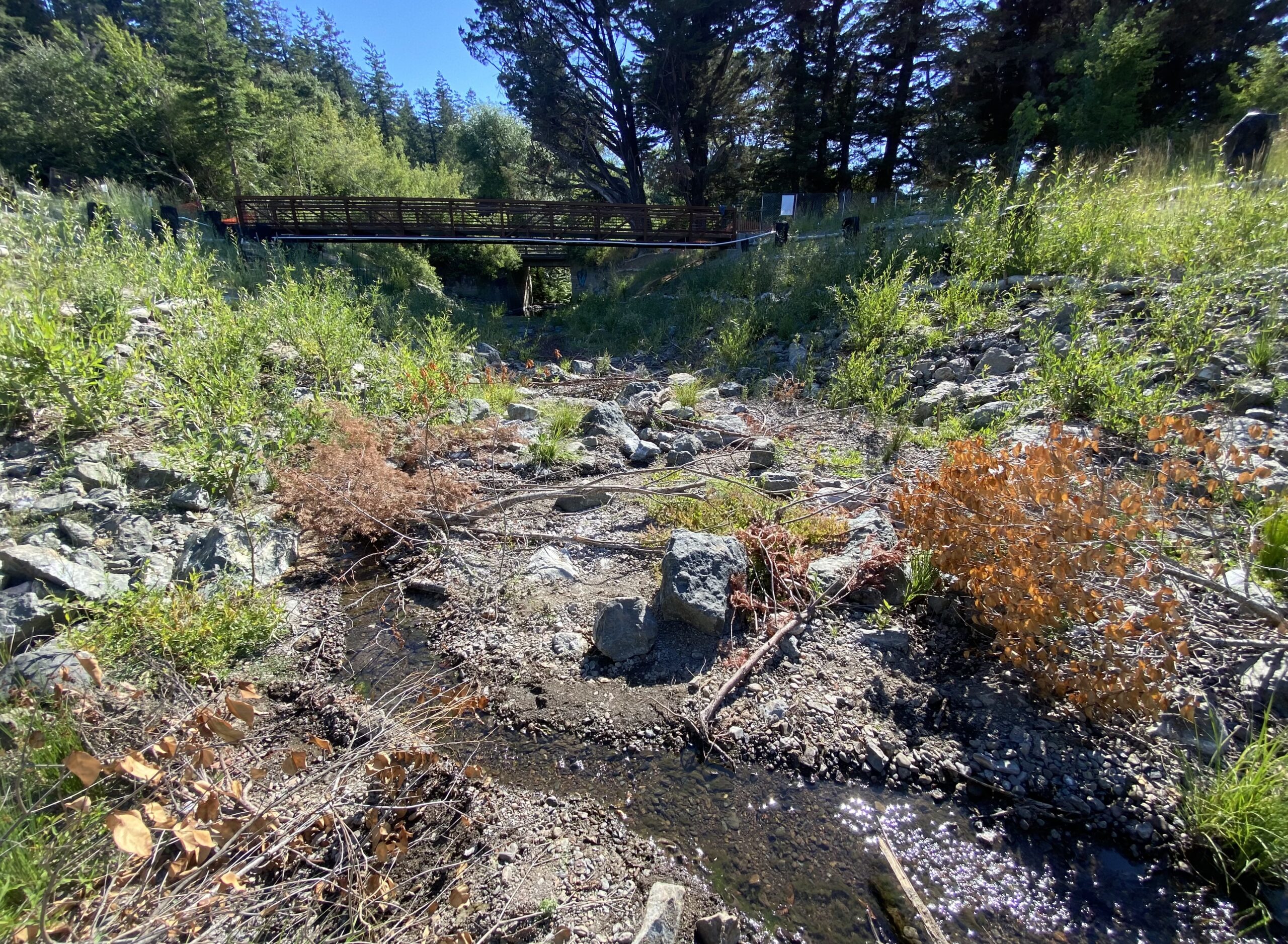Salmon Habitat Restoration in the Face of Drought
Written by Ayano Hayes, SPAWN Watershed Biologist
We are approaching one year from the removal of Roy’s Dam on San Geronimo Creek, which was NOAA’s highest priority fish barrier to remove for recovering endangered central California coast coho salmon (Oncorhynchus kisutch). The removal of Roy’s Dam, and the formation of what we’re calling “Roy’s Riffles,” now restores unimpeded fish passage above the former dam and will soon below when the County of Marin modifies the sill under San Geronimo Valley Drive. However, we are currently in a historic drought. Little streamflow matched with increased temperatures have exacerbated drought conditions across California and we’re seeing significant effects of the drought in our streams and rivers. Throughout San Geronimo Creek, creek flow is becoming disconnected, habitat is limited, water quality has declined, and algae blooms persist. This is even happening at the Roy’s Riffles site.
During the first winter after dam removal, the site experienced a few small storms that brought a large volume of sediment down into the constructed channel. This sediment is made up of spawning gravels and small stones that make great habitat. However, with little rainfall and not enough water to flush the sediment further downstream, the low flow path of Roy’s Riffles, which allows continuous surface flow during summer, has piped under the loose gravel in some places. It’s normal for sediment to shift, settle, and move over time. Rivers are dynamic systems and with enough sediment transport, streambeds become resilient to changes in sediment patterns, always providing habitat and surface flow.
As part of SPAWN’s on-going project management and maintenance practice, we continue to make small adjustments to ensure creek flow continues; working with the collected sediment and adding brush bundles in the deeper pools to help shade and provide cover for fish. This adaptive work is a result of continuous monitoring of the site and a way to assure that surface flows continue under the severe drought conditions presented.
SPAWN, the California Department of Fish and Wildlife, and the engineers with the Environmental Science Association are excited about the signs of recovery that are apparent at the site: streamside willows are thick and growing tall; upslope trees are putting on fast growth; and birds, mammals, reptiles, and other wildlife have been seen foraging at and near the site, including a bald eagle! We can’t forget to mention that during the critical months of fish migration, adult coho salmon and steelhead were observed navigating through the restored area heading upstream to spawn, and a healthy population of coho smolts were recorded moving downstream through the low flow channel to make their way to the ocean! Restoration efforts take time to fully mature, but immediate progress is obvious and wildlife have quickly adapted to using the new habitat.
The native plants planted in the winter have been doing exceptionally well, with a high survival rate. A lot of energy has been put into revegetation and irrigation of the site to allow plants to become well established within their first year. More than 65 different species of native plants, grown with the help of SPAWN volunteers, consisting of trees, shrubs, perennials, annuals, and grasses have been planted onsite already. Additional plantings will occur in subsequent years.
Some of the native trees planted include arroyo willow (Salix lasiolepis), Sitka willow (Salix sitchensis), big leaf maple (Acer macrophyllum), California buckeye (Aesculus californica), blue elderberry (Sambucus nigra), and coast redwood (Sequoia sempervirens). The trees, shrubs, perennials, and grasses will quickly revegetate the site and will form a fully native riparian habitat. Weed management is currently underway to control the spread and dispersal of invasive plants and grasses. SPAWN staff, interns, and volunteers are frequently at the site removing weeds, mulching, and maintaining the plantings and we welcome all who want to help!
To commemorate the special nature of this site, redwood trees have been planted on the north-facing slope of the restoration area. The redwoods are dedicated to our volunteer base, who have devoted their time and support to SPAWN throughout the years. Several volunteers have been working with SPAWN for more than 15 years. This grove of redwoods, called the Volunteer Grove, is for all of our volunteers, who form the core of the organization. The Volunteer Grove will grow and stand long after us, reminding us that this kind of work can never be done alone, and that small actions taken by individuals can make a significant impact in the world.
The protection of the endangered coho salmon population that resides within the Lagunitas Watershed is what drives the work we do. We strive to not only create more available habitat, better fish passage, and refuge within these streams, but to also restore the land for the benefit of all wildlife and people. We appreciate the support that the community has given to this important restoration project and we’re so grateful to be part of a community that cares so much about the health of the riparian ecosystem which is the heart of the San Geronimo Valley.
To become a volunteer or learn how to get involved, please visit our online event calendar and follow SPAWN on Facebook and Instagram.
- Adult coho salmon and steelhead were observed navigating through the restored area in the winter.
- Streamside willows planted by SPAWN volunteers are thick and growing tall.
- SPAWN Intern Matt Fernandez helps weed the restoration site.
- An overview of the Roy’s Riffles site in Lagunitas, California.
- Volunteers help remove invasive plants at the site.









